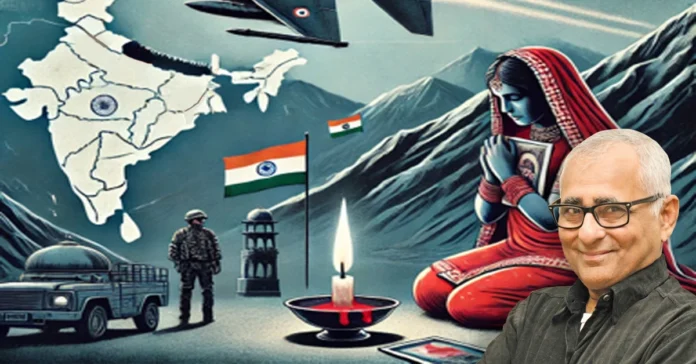By Inderjit Badhwar
On April 22, 2025, the blood of innocent civilians—tourists, families, children—was spilled in Pahalgam, a place once known more for its serene landscapes than for its association with terrorism. What unfolded that day was not just another terror attack; it was a calculated massacre. The victims weren’t combatants. They were ordinary people whose lives were cut short by bullets fired in cold, execution-style fashion. It was an act of savagery that demanded not only mourning but a resolute, meaningful response.
India’s answer came in the form of Operation Sindoor—a calibrated military strike targeting nine known terrorist camps inside Pakistan and Pakistan-occupied Kashmir (PoK). These were not random retaliations. These were precise operations against facilities with verified intelligence links to terror outfits like Jaish-e-Mohammad (JeM) and Lashkar-e-Taiba (LeT), organizations with long histories of orchestrating bloodshed on Indian soil.
As editors, we recognize that words like “retaliation” and “strike” carry heavy weight, especially in a subcontinent as volatile as ours. But it is critical that the world understands the nature of India’s action: this was not a declaration of war; it was a demonstration of resolve.
The name Operation Sindoor was not chosen lightly. It reflects the grief of the women who lost husbands, sons, and brothers in the Pahalgam attack. It is an invocation of mourning, not militarism. And yet, it sends an unmistakable message: India will no longer absorb such horrors in silence.
For years, India has been accused—both internally and externally—of being slow to respond to cross-border terrorism. But this time, New Delhi chose decisiveness over dithering. The Indian Air Force, guided by precise intelligence, struck nine terrorist facilities used for recruitment, indoctrination, and operational planning. These included the Markaz Taiba in Muridke, where the 26/11 attacker Ajmal Kasab was trained; the JeM hub in Bahawalpur; and several staging camps in Muzaffarabad and Kotli, all of which had direct operational ties to the Pahalgam attack and others like it.
What is worth reiterating is that these strikes were meticulously planned to minimize civilian casualties. India refrained from targeting civilian infrastructure. Unlike indiscriminate violence, this was a doctrine of proportional response—rooted in deterrence, not domination.
Pakistan’s reaction was predictable: denial, counter-allegations, and a narrative of victimhood. It claimed the Pahalgam attack was a “false flag,” dismissed Indian intelligence, and accused New Delhi of warmongering. At the same time, it claimed to have shot down five Indian jets—a claim that remains unverified. The smoke of disinformation is thick, but the facts are clear to anyone who dares to see them: the world cannot continue to look away from Pakistan’s role as an incubator of terrorism.
This magazine has always believed that war is a failure of politics, of diplomacy, and of humanity. But when a nation is faced with a direct assault on its people, and when its pleas for accountability are met with evasion and denial, it has both the right and the responsibility to act. India acted not out of vengeance, but from necessity.
The international community must now reckon with a hard truth: terrorism that finds safe harbour in one country can destabilize an entire region. The South Asian Association for Regional Cooperation (SAARC) has already been comatose for over a decade due to India-Pakistan hostilities. The dream of a prosperous, cooperative South Asia remains hostage to one country’s unwillingness to dismantle its terror apparatus.
The world must not only condemn the Pahalgam attack, but must also understand the pattern. From Uri in 2016 to Pulwama in 2019, and now Pahalgam in 2025, India’s citizens have suffered repeated traumas rooted in cross-border terrorism. The strikes in Operation Sindoor were not the beginning of a new war—they were the continuation of an unfinished fight for justice.
The consequences of inaction are too grave to ignore. Just as the 26/11 Mumbai attacks reshaped global understanding of urban terrorism, the execution-style murders in Pahalgam should be a wake-up call for world capitals. Silence in the face of such cruelty is complicity.
At the same time, India’s restraint must also be acknowledged. It has not bombed cities. It has not crossed thresholds recklessly. It has targeted perpetrators, not populations. While Pakistan suspended diplomatic pacts like the Simla Agreement and threatened escalation, India has remained focused on surgical, defensible goals. Even as it suspended the Indus Waters Treaty, the actions were calibrated to emphasize leverage, not annihilation.
The road ahead is fraught. Both sides are on edge, civilians are evacuating border towns, and the risk of escalation remains. Yet amidst all this, India’s core message must not be lost: it does not seek war. It seeks justice. The people of India want security, not sabre-rattling. But they will not accept impunity for terrorists, nor sanctuary for their sponsors.
In this issue, we take you inside Operation Sindoor—from the decision-making rooms in New Delhi to the airstrikes that lit up terrorist hubs across the border. We examine the political, diplomatic, and human dimensions of a moment that may shape South Asia’s future.
We owe it to the victims of Pahalgam—and to the civilians who live in fear on both sides of the border—to report this story with clarity, courage, and context.


